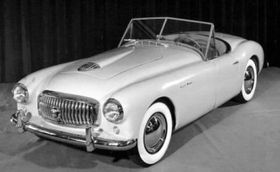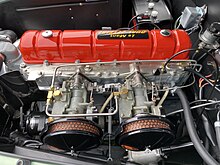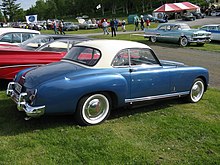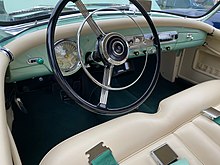Nash-Healey
| Nash-Healey | |
|---|---|
 1951 Nash-Healey | |
| Overview | |
| Manufacturer | Nash Motors |
| Also called | Series 25 |
| Production | December 1950 – August 1954 |
| Model years | 1951–1954 |
| Assembly |
|
| Designer |
|
| Body and chassis | |
| Class | Sports car |
| Body style | |
| Layout | Front-engine, rear-wheel-drive |
| Platform | Warwick Healey chassis |
| Related | Alvis-Healey |
| Powertrain | |
| Engine | |
| Transmission | 3-speedmanualwithoverdrive |
| Dimensions | |
| Wheelbase |
|
| Length |
|
| Width |
|
| Height |
|
| Curb weight | 2,400 lb (1,089 kg) ~ approximate |
TheNash-Healeyis a three-seat luxurysports carorgrand tourerproduced from 1951 to 1954. It was marketed by theNash-Kelvinatorconglomeratein North America as ahalo carto promote sales of itsNash Motorsdivision.
The car resulted from a joint venture between Nash-Kelvinator and British automaker, theDonald Healey Motor Company.Nash supplied thedrivetrainfrom their range-toppingAmbassadormodel, and Healey provided the chassis and early bodies. One year after its introduction, the car was restyled byPininfarina,and the final assembly was transferred to Italy. Some describe the Nash-Healey as the first sports car introduced in the U.S. by a major automaker after theGreat Depression.[2][3]
Various Nash-Healeys, some modified road cars, and some purpose-built racers competed in several endurance racing events, most notably posting a third-place finish at the1952 24 Hours of Le Mans.
Origin
[edit]In December 1949, British engineer, rally driver, and automakerDonald Healeysailed for America aboard theRMSQueen Elizabethocean liner.[4][5]He was going for a meeting withGeneral Motors' (GMs)Ed Cole,hoping to secure a supply ofCadillac's new 331 cu in (5.4 L) V8 engine.Healey planned to use the engines in his company'sHealey Silverstoneclub racer. Two such Healey/Cadillac hybrids had already been built, one in the US by American sportsmanBriggs Cunningham,and one in England by Healey's own Donald Healey Motor Company; the Cadillac-enginedX 4prototype.[6][7][8]
While aboard ship, Healey encountered a man using an elaboratestereo camerasystem that intrigued him.[9][10]The man wasGeorge W. Mason,president of Nash-Kelvinator. The two made an acquaintance based on their shared interest inphotography.Hearing Healey's plan and anticipating GM's reply, Mason told Healey to contact him if the negotiations were unsuccessful.[11]When GM turned Healey down due to their defense commitments, Healey contacted Mason, and development of the Nash-Healey started.
As part of the arrangement between the companies, Nash paid off Healey's £50,000 bank debt, which was to be repaid in assembled cars.[12][13][4][10]
A prototype was previewed at theParis Motor Showin October 1950.[5][10]The fate of this car is unknown.[citation needed]The Nash-Healey made its official debut in February of the following year at the 1951 Chicago Auto show.[5]The car's full name is the Nash-Healey Series 25.[14]
Some time after its release, the Chrysler Corporation purchased a Nash-Healey from a Detroit dealership, disassembled it, and submitted an analysis of it to the company executives.[15]
The 1951 Nash-Healey is called the first post-war sports car from a major American automaker, as it was released two years before theChevrolet Corvette.[16]This appellation excludes the limited volumeKurtis-KraftandMuntz Jet,as well as the diminutiveCrosleyHotshot, Super Hotshot, and Super Sport roadsters.[17][16]
Features
[edit]
Nash supplied Healey's company with thepowertraincomponents: theAmbassador'sinline six-cylinder OHV 234.8 cu in (3.85 L) engine and three-speed manual transmission withBorg-Warneroverdrive.Healey fitted a lighter, higher-compression aluminum cylinder head (in place of the cast-iron stock item) with twin 1.75-inch (44 mm)SU carburetors.This increased power from the stock 112 hp (84 kW; 114 PS) version to 125 hp (93 kW; 127 PS).
The chassis was a widened and reinforced Healey Silverstone[18]box-section ladder-type steel frame. Independent front suspension, also Healey Silverstone, was bycoil springs,trailing link,and ananti-roll bar.The rear suspension featured a Nash-suppliedtorque tubeandlive axle,replacing the Silverstone'sRiley Motorparts.[19][5]Lateral location of the axle was handled by aPanhard rod.
Healey designed the aluminum body, but it wasoutsourced.Panelcraft Sheet Metal ofBirminghamfabricated the body.[20]It incorporated a Nash grille, bumpers, and other trim.[21]Healey was responsible for the car's final assembly.
The car haddrum brakesall around. Wheels were steel, with full-diameter chrome hubcaps and 4-ply 6.40×15-inchwhitewall tires.The interior featured luxurious leather upholstery, foam rubber cushions, an adjustable steering wheel, and a cigarette lighter. Completed vehicles were shipped to the United States and marketed through the Nashdealershipnetwork.
Model years
[edit]1951
[edit]
The 1951 Nash-Healey was the first post-war sports car from a major American automaker, two years ahead of theChevrolet Corvette.[16]The custom-builtKurtis-Kraftwhich predated it never reached "production car" status, with 18 units being built.[17][16]
A prototype was exhibited at theParis Motor Showin September 1950. The production model debuted at the February 1951Chicago Auto Show,[20]followed that month by the Miami Auto Show.[17]Also classified as a grand tourer for its luxury appointments and extreme price, the car served its purpose and was campaigned in several racing circuits.[22][23][24]
Donald Healey gave the first example toPetula Clark,[20]with the registration number PET 1.[clarification needed]The only colors available were "Champagne Ivory" and "Sunset Maroon". Thesuggested retail price(MSRP) ofUS$3,767F.O.B.New York Citywas considered to be high priced.[25]
1952
[edit]

For the 1952 model year, Nash commissioned Italian designerBattista Farinaand his carrozzeria,Pinin Farina,to revise the original body design. One objective was to make the new sports car resemble the rest of Nash's models more closely. The front received a new grille incorporating inboard headlights. The sides gained distinct fender character lines ending with smalltailfinsin the rear. A curved windshield replaced the previous two-piece flat windshield. The restyled car appeared at that year'sChicago Auto Show.[26]Reflecting its role as ahalo car,the Nash Ambassador and Statesman models adopted a Nash-Healey-inspired grille with inboard headlights for 1955, and advertising featured the new Nash with a Nash-Healey in the background to show the similarity.
Pininfarina inTurinbuilt the steel bodies with the exception of the aluminum hood, trunk lid, and dashboard.[27]The aluminum panels, plus careful engineering, reduced curb weight.[28]The Nash engine was enlarged to 252 cu in (4.1 L), producing 140 hp (104 kW; 142 PS) with American-made twinCarter Carburetors.
Shipping costs were considerable and moderated by Kelvinator's trans-Atlantic success in the European marketplace. FromKenosha, Wisconsin,the Nash engines anddrivetrainswent to England for installation in the Healey-fabricated frames. Healey then sent the rolling chassis to Italy, where Pininfarina's craftsmen fashioned the bodywork and assembled the finished product. They were then exported to the U.S., with the car's complicated logistical process resulting in a $5,908sticker pricein 1953, approaching double the new Chevrolet Corvette's $3,513.[29]
1953
[edit]

The 1953 model year saw the introduction of a new closed coupe[30]alongside the roadster (now termed a "convertible" ). Capitalizing on the 3rd-place finish atLe Mansby a lightweight racing Nash-Healey purpose-built for the race (see below), the new model was called the "Le Mans" coupe.[31]Nash had already named the engine the "Le-Mans Dual Jetfire Ambassador Six" in 1952, in reference to the previous racing exploits of the lightweight competition cars.[28]
Some describe the new design as "magnificent".[32]Some "people didn't take to the inboard headlights".[33]This headlight mounting was described as "Safety-Vu" concentrating illumination, and their low position increased safety under foggy conditions. The 1953 "Le Mans" model was awarded first prize in March of that year in theItalian International Concours d'Eleganceheld atStresa,Italy.[34]
Leveraging the popularity of golf to promote their cars, Nash Motors and Nash dealers sponsored what the automaker described as "more than 20 major golf tournaments across the country" in 1953, and golferSam Sneadwas shown with his Nash-Healey roadster on the cover of the June 1953 issue ofNash News.[35][36]
Product placementwas another marketing strategy. A roadster owned byDick Powellwas driven byGeorge Reeves,as Clark Kent, in four TV episodes of theAdventures of Superman.[37][38]Another roadster appears in the 1954 filmSabrinastarringHumphrey Bogart,William Holden,andAudrey Hepburn.[39]
1954
[edit]
Nash-Kelvinator became reorganized as a division ofAmerican Motors Corporation(AMC) that was formed as a result of a merger withHudson Motor Car Companyon 1 May 1954. Nash was faced with limited resources for marketing, promotion, and further development of this niche market car compared to its volume models.[40]By this time AMC knew that a similar luxurious two-seatFord Thunderbirdwith V8 power was being planned. In light of the low sales for the preceding years, Nash delayed the introduction of the 1954 models until 3 June and discontinued the convertible, leaving just a slightly reworked "Le Mans" coupe, distinguished by a reverse slanted "C" pillar and a three-piece rear window instead of the previous one-piece glass.
Healey was focusing on its newAustin-Healey 100,"and the Nash-Healey had to be abandoned."[41]Although the international shipping charges were a significant cost factor, Nash cut the POE (port of entry) price by more than $1,200 to $5,128. Production ceased in August. A few leftover 1954s were sold as 1955 models.[42]
Production
[edit]
All 1951 Nash-Healeys were British-built. Bodies were crafted at Panelcraft Sheet Metal, and final assembly was completed at the Healey factory in Warwick. The 1952 through 1954 models were built in Italy by Pinin Farina.
| Nash-Healey production numbers | |
|---|---|
| 1951 | 104 |
| 1952 | 150 |
| 1953 | 162 |
| 1954 | 90 |
| Total | 506 |
The Nash-Healey registry has 520 entries, including prototypes and race vehicles.[7]
For contextual comparison, the Nash-Healey is framed in U.S. auto history with the 1953Kaiser Darrin,1953Chevrolet Corvette,and 1955Ford Thunderbird.The 1954 model year Nash-Healey price to the public was close to $6,000 compared with around $3,500 for a Chevrolet Corvette and $3,000 for a 1955 Ford Thunderbird.[6]
Technical data
[edit]| Nash-Healey | 1951 Roadster | 1952 Roadster | 1953 Convertible | 1953-54 Coupe |
|---|---|---|---|---|
| Engine: | Nash Ambassador Dual JetfireOHVinline 6 | Nash Ambassador Le Mans Dual Jetfire OHV inline 6 | ||
| Engine materials: | Cast ironblock, aluminum cylinder head | |||
| Bore × Stroke: | 3.375 in × 4.375 in (86 mm × 111 mm) | 3.5 in × 4.375 in (89 mm × 111 mm) | ||
| Displacement: | 235 cu in (3,851 cc) | 253 cu in (4,146 cc) | ||
| Compression ratio: | 8.1:1 | 8.25:1 | ||
| Maximum power: | 125 bhp (93 kW) at 4000 rpm | 140 bhp (104 kW) at 4000 rpm | ||
| Maximum torque: | 210 ft⋅lb (285 N⋅m) at 1600 rpm | 230 ft⋅lb (312 N⋅m) at 2000 rpm | ||
| Valvetrain: | Singlecam-in-block,pushrods, rocker arms, two overhead valves per cylinder | |||
| Induction: | 2 ×SUH4 | 2 ×CarterYH | ||
| Cooling: | Water-cooled | |||
| Transmission: | Borg WarnerT-86E 3-speedmanualwith Borg Warneroverdrive | |||
| Steering: | Marles steering gear[43] | |||
| Brakes f/r: | Bendix 10 in (254 mm) drums / 10 in (254 mm) drums | |||
| Suspension front: | Trailing arms,coil springs,hydrauliclever arm dampers,anti-roll bar | |||
| Suspension rear: | Torque tube,live axle,radius rods, coil springs, telescopic dampers,Panhard rod | |||
| Body/Chassis: | Light alloy body, steel chassis | Steel and alloy body, steel chassis | ||
| Track f/r: | 53 / 53 in (1,346 / 1,346 mm) | 53 / 54.87 in (1,346 / 1,394 mm) | ||
| Wheelbase: | 102 in (2,591 mm) | 108 in (2,743 mm) | ||
| Tyres f/r: | 6.40 - 15 | |||
| Length Width Height: |
170 in (4,318 mm) 66 in (1,676 mm) 55.5 in (1,410 mm) |
170.75 in (4,337 mm) 64 in (1,626 mm) 48.65 in (1,236 mm) |
180.5 in (4,585 mm) 65.87 in (1,673 mm) 55 in (1,397 mm) | |
| Weight: | 2,780 lb (1,261.0 kg) | 2,920 lb (1,324.5 kg) | 3,140 lb (1,424.3 kg) | |
| Maximum speed: | 103 mph (166 km/h) | |||
| Acceleration 0–60 mph (0–97 km/h): | 11.5 seconds | |||
Motorsports
[edit]Panamericana pace car
[edit]A Nash-Healey served as the course car for the 1951Carrera Panamericana,described as one of the most dangerous automobile races of any type in the world. Driven byChuck Stevenson,the Nash-Healey ran ahead of the racers to ensure the way was clear on "the world's greatest road race".[44]
Endurance racing
[edit]To create a racing pedigree for the marque, Donald Healey built four lightweight Nash-Healeys forendurance racing[45]Like the road cars, they had Nash Ambassador engines and drivelines. However, fitting higher-compression aluminum cylinder heads, special manifolds, and twin SU carburetors increased their power to 200 hp (149 kW; 203 PS). The cars had spartan, lightweight aluminum racing bodies. Three open versions were built, and one coupe. These cars competed in four consecutiveLe Mansraces and oneMille Miglia.
1950 Le Mans
[edit]Tony RoltandDuncan Hamiltondebuted the prototype atLe Mans in 1950.It was the first-ever Le Mans entry to have an overdrive transmission. Not only was the car one of the 29 finishers from the field of 66,[46]but also finished in fourth place. This outstanding achievement sealed Healey's contract with Nash for a limited production run of the road cars.[47]Roger Menadue, head of Healey's experimental department, played a significant role in the success: He filed slots in the backplates of the brakes and extended the adjusting mechanism to a small exterior lever. Thus, in a matter of seconds, he could adjust the brakes during pit stops without jacking the car up—an innovation that saved as much as half an hour at each stop.[48]
1951 Le Mans
[edit]In the1951 Le Mans race,Rolt and Hamilton took fourth in class and sixth overall behind a Jaguar, twoTalbot-Lagosand twoAston Martins.They finished immediately ahead of twoFerrarisand another Aston Martin.[49]
1952 Le Mans
[edit]
In the1952 Le Mans race,when only 17 of the 58 starters finished, the entry driven byLeslie Johnsonand motoring journalistTommy Wisdom[50]took third overall behind two factory-enteredMercedes-Benz 300SLs;also first in class, ahead ofChinetti's Ferrari, and second in the Rudge-Whitworth Cup for the best performance over two consecutive years. In addition, they won the Motor Gold Challenge Cup. The drivers said the car was more nimble through the corners than its more exotic competitors. It delivered 13 mpg‑US(18 L/100 km; 16 mpg‑imp) and the engine needed no oil or water during the entire 24 hours.[51]The car had been built from scratch in a fortnight, Menadue and his assistant Jock Reid fabricating the body in less than a week, by eye, without any drawings. Healey said: "That's an ugly bugger, isn't it, Roger?"[48]
1952 Mille Miglia
[edit]The same year, Johnson raced the car in theMille Miglia,the thousand-mile Italian road race that would be banned as too dangerous five years later.Daily Telegraphmotoring correspondent Bill McKenzie rode as passenger.[52]They finished a creditable seventh overall toBracco's winning works team Ferrari, the works Mercedes-Benz 300SLs ofKlingandCaracciola,and three worksLancias;[53]they also took fourth in class. The coupe driven by Donald Healey and his son Geoffrey crashed out.[51]
1953 Le Mans
[edit]For the1953 Le Mans race,the factory partnered Johnson with Bert Hadley in one of two cars with redesigned bodies. Johnson started in 27th place. Although he and Hadley advanced steadily up the race order, they were 11th at the finish, 39 laps behind the winning Jaguar, despite an average speed of 92.45 miles per hour (148.78 km/h)—higher than the previous year's run to third place.[31]However, they beat both of Donald Healey's newAustin-Healey 100s.The second Nash-Healey ofVeyronandGiraud-Cabantousretired after nine laps.
This concluded the factory's race program with the lightweight competition cars. The 1952 Le Mans/Mille Miglia car passed into private ownership and raced in America.[54]
Planned successors
[edit]Wisp
[edit]Nash's designer, Ed Anderson, wanted to bring the design for a successor to the Nash-Healey back in-house after Pinin Farina restyled the car for 1952. In 1953, he created theWisp.Sketches of the car show a low 2-seater with a tapering tail and side coves, foreshadowing the Corvette. Master Modeler Charl Greene created a wooden scale model of the Wisp to show to management, but Nash did not have the resources to fund the development of a new car for a small market. Anderson requested a quote from Pinin Farina to have a single copy built for him, but did not proceed with the project.[55]
Palm Beach
[edit]The 1956 Nash RamblerPalm Beachwas a design commissioned by Mason as a possible successor to the Nash-Healey. Pinin Farina drew the shape. This 2-seater featured a large circular air intake at the front, reminiscent of Farina's Lancia PF200 of 1953, and prominent tail fins.[56][57]The car was built on a Nash Rambler chassis and is powered by a Rambler straight-sixflathead enginemated to a three-speed manual transmission.[58]The car debuted on Farina's stand at the 1956 Turin Auto Show, after which it was in the personal collection of Roy Chapin Jr., CEO and Chairman of American Motors, until Joe Bortz purchased it. In 2007, the Palm Beach was bought by Jacques Harguindeguy.[56]
Alvis-Healey
[edit]In Britain, Healey sold a model with Hodges' original Nash-Healey bodywork as theHealey Sports Convertible.A different piece replaced the Nash grille, the power bulge in the hood was deleted, and other minor features, such as a scuttle vent, fog lamps, and revised wheel covers, were added.[59]: 4
Powering the car was a 3.0 L (183 cu in) inline six-cylinder engine from theAlvis TB 21fed by two SU carburetors.[59]: 4 Built on a G-Type chassis; it is commonly called theAlvis-Healey.[5]
The Alvis-Healey also used the clutch and transmission from Alvis, and replaced the Nash-Healey's torque tube rear drive with a rigidSalisburyaxle suspended on coil springs and located by trailing links, with the drive reaching the rear axle via an openHardy-Spicerdriveshaft.[5][60]: 2, 3 [59]: 4
Approximately twenty-five examples were built.[5][61]: 10
References
[edit]- ^"1953 Nash album".oldcarbrochures.com.pp. 6–7.Retrieved17 May2024.
- ^"Nash Builds a Sports Car".Popular Mechanics.Vol. 95, no. 3. March 1951. pp. 107–109.Retrieved17 July2022– via Google Books.
- ^Schorr, Martyn L. (26 November 2019)."Nash-Healey: First American Sports Car".Car Guy Chronicles.Retrieved17 May2024.
- ^ab"Donald Healey — The Man Behind the Cars"(PDF).Nash Healey Newsletter.Nash Healey Registry. June 2012. pp. 8, 9.Retrieved17 May2024.
- ^abcdefgSeverson, Aaron (1 March 2012)."Born on a Boat: Donald Healey and the Story of the Nash-Healey (Donald Healey Meets George Mason)".Ate Up With Motor.Retrieved17 May2024.
- ^abWilson, Jeremy."History and Production Notes".Popular Restorations.Retrieved2 November2020.
- ^ab"Nash-Healey Chassis Numbers".Nash Healey Registry.Retrieved17 May2024.
- ^Neville, Rick (July–August 2016)."Nasty Boys"(PDF).Austin Healey Magazine.pp. 8–11.
- ^Schreiber, Ronnie (2 August 2014)."Stereo Realists: Donald Healey, George Mason and How the 3D Craze Led to the Nash-Healey".The Truth About Cars.Retrieved2 November2020.
- ^abcSchreiber, Ronnie (17 December 2019)."The Nash-Healey was a car ahead of its time".Hagerty.
- ^Warwick Healey Motor Company Catalogue(Report). Heritage & Culture Warwickshire. November 2017.Retrieved17 May2024.
- ^Mays, James C. (Spring 2011)."Found! Nash-Healey X-7"(PDF).Automotive History Review(37): 38–40.
- ^Lotsengård, Anders (October 2014). "Healey History — sista delen" [Healey History — last part].Austin Healey Enthusiast.No. 134. pp. 4–7.
- ^"1951 Nash-Healey Series 25".Hagerty.
- ^McClurg, Bob (18 June 2021).The History of AMC Motorsports: Trans-Am, Quarter-Mile, NASCAR, Bonneville and More.Cartech Auto Books & Manuals.ISBN978-1-61325-177-5.
- ^abcdJedlicka, Dan."1951-54 Nash-Healey History".Retrieved13 April2015.
- ^abcBomstead, Carl (August 2013)."1950 Nash-Healey Roadster".Archived fromthe originalon 27 July 2021.Retrieved13 April2015.
- ^"1950 Healey Silverstone".How Stuff Works.24 October 2007. Archived fromthe originalon 28 January 2021.Retrieved17 July2022.
- ^Foster, Patrick (26 May 2020)."Nash-Healey: International Sports Car".Old Cars Weekly.Retrieved17 May2024.
- ^abcHulme, Ann."From Ann Hulme".Nash Car Club.Retrieved13 April2015.
- ^Vance, Bill (1994).Reflections on automotive history, Volume 1.Eramosa Valley Publications. p. 137.ISBN978-0-9698922-0-5.
- ^Langworth, Richard M. (1986). Consumer Guide (ed.).Complete book of collectible cars, 1930-1980.Random House. pp. 174–175.ISBN978-0-517-47934-6.Retrieved9 March2019.
Le Mans roomy, a genuine GT
- ^Wagner, Rob Leicester (1998).Style and Speed: The World's Greatest Sports Cars.MetroBooks. p. 35.ISBN978-1-56799-633-3.
- ^"U.S. Challenge in the Le Mans 24 Hours Race".The Motor.Vol. 125. England. 1964. p. 60.Retrieved17 July2022– via Google Books.
- ^Vance, Bill (16 September 2005). "Reflections: Healey's creations helped make British sports cars popular".The London Free Press.
- ^"1952 Nash-Healey".Pacific Northwest Region Nash Car Club of America.Retrieved13 April2015.
- ^LaChance, David (October 2007)."1953 Nash-Healey LeMans Coupe".Hemmings Sports & Exotic Car.Retrieved17 July2022.
- ^ab"1952 Nash-Healey".How Stuff Works.27 October 2007. Archived fromthe originalon 26 January 2020.Retrieved17 July2022.
- ^Lyons, Dan (2005).Cars of the Fantastic '50s.MBI Publishing. pp. 43–45.ISBN978-0-87349-926-2.Retrieved13 April2015.[permanent dead link]
- ^"Nash-Healey Adds LeMans Hardtop to Sports Line".Popular Mechanics.Vol. 99, no. 5. May 1953. p. 101.Retrieved17 July2022– via Google Books.
- ^ab"1953 Nash-Healey".How Stuff Works.27 October 2007. Archived fromthe originalon 19 September 2020.Retrieved17 July2022.
- ^Adler, Dennis; Moss, Stirling (2001).Mercedes-Benz: Silver Star Century.MBI Publishing. p. 90.ISBN978-0-7603-0949-0.Retrieved13 April2015.[permanent dead link]
- ^Langworth, Richard M. (1975).Kaiser-Frazer, the last onslaught on Detroit: an intimate behind the scenes study of the postwar American car industry.Automobile Quarterly Publications. p.200.ISBN978-0-915038-04-6.
- ^Conde, John (8 September 1975)."Nash-Healey (1951-54)".carmemories.Retrieved13 April2015.
- ^"Nash cashes in on the popularity of golf to sell more cars".Nash News.Nash Motors. June 1953.
- ^"Nash-Healey Roadster - Auction 20-21/1, Listing Date: 6 December 2010".carandclassic.com.Archived fromthe originalon 7 September 2011.Retrieved13 April2015.
- ^Koza, Lou (15 April 2006)."This is a car... for Superman!".The Adventures Continue Website.Retrieved13 April2015.
- ^Watterson, Thomas (31 January 1991). "Collectibles: Porky Pig Meets The Big, Bad Wolf".The Boston Globe.
His collection includes the "Superman car," a 1953 Nash-Healey driven by the Clark Kent character in the 1950s television series.
- ^"Sabrina (1954) Trivia".Internet Movie Cars Database.Retrieved13 April2015.
- ^"The Nash-Healey's Demise".How Stuff Works.27 October 2007. Archived fromthe originalon 18 October 2018.Retrieved17 July2022.
- ^Bonds, Ray (2003).Illustrated Directory of Sports Cars.MBI Publishing. pp. 378–379.ISBN978-0-7603-1420-3.
- ^"1954 and 1955 Nash-Healey".How Stuff Works.27 October 2007. Archived fromthe originalon 29 July 2018.Retrieved17 July2022.
- ^"Original Equipment Users - MARLES Steering Box".Marles Steering Boxes.
- ^Tipler, Johnny; Ramirez, Jo (2008).La Carrera Panamericana: "The World's Greatest Road Race!".Veloce Publishing. p. 26.ISBN978-1-84584-170-6.Retrieved13 April2015.
- ^Kaufmann, Richard M. (October 1970)."Nash-Healey at Le Mans".Special Interest Autos.Hemmings. Archived fromthe originalon 11 November 2007.Retrieved17 July2022.
- ^"The Nash-Healey and the 1950 LeMans 24 Hours".How Stuff Works.27 October 2007. Archived fromthe originalon 2 July 2017.Retrieved17 July2022.
- ^Conde, John (8 September 1975)."Nash-Healey (1951-54)".AMX Files. Archived fromthe originalon 27 March 1997.Retrieved13 April2015.
- ^ab"Roger Menadue: Motor engineer whose unorthodox approach fuelled the race-circuit success of the Healey's stable".The Times.22 March 2003.Retrieved13 April2015.
- ^"1951 Nash-Healey".How Stuff Works.27 October 2007. Archived fromthe originalon 26 January 2020.Retrieved17 July2022.
- ^"Image Preview: Tommy Wisdom, winner of the Grand Turismo Class of the Mille Miglia".Motoring Picture Library. 2004.Retrieved13 April2015.
- ^ab"The Nash-Healey's 1952 Racing Record".How Stuff Works.27 October 2007. Archived fromthe originalon 26 January 2020.Retrieved17 July2022.
- ^"Sports Cars on Stamps".Car Keys. 12 August 2004. Archived fromthe originalon 12 August 2004.Retrieved13 April2015.
- ^"World Sports Racing Prototypes, Non Championship Races 1952, Mille Miglia results".wsrp.ic.cz.24 December 2011. Archived fromthe originalon 22 February 2015.Retrieved13 April2015.
- ^Wheels TV Film about the 1952 Le Mans/Mille Miglia Nash Healey; includes Le Mans footage.Retrieved 22 March 2008.Archived22 September 2008 at theWayback Machine
- ^Foster, Pat (April 2022)."A Nash That Never Was".Hemmings Classic Car.
- ^abDellis, Nick (20 May 2016)."Nash Rambler 'Palm Beach' Coupe".Supercars.net.
- ^"Pininfarina Nash Rambler Palm Beach Coupe Special 1956".Coachbuild.com.29 July 2017.
- ^"Pinin Farina's Rambler Palm Beach".Hemmings Classic Car.
- ^abc"NEW 3-litre HEALEY"(PDF).Nash Healey News.No. 34. January–February 1986. p. 4.
- ^"The HEALEY 3-litre Sports Convertible"(PDF).Nash Healey News.No. 23. July 1984. pp. 2, 3.
- ^"Alvis Healey"(PDF).Nash Healey News.Vol. 6, no. 1. January 1977. p. 10.
Further reading
[edit]- "The Nash-Healey"(PDF).The Motor.4 October 1950.
- "100 percent for DOLLAR EXPORT"(PDF).The Motor.11 April 1951.
- Van Osten, Dick (September 1951)."Proving ground shakedown of the Nash-Healey"(PDF).Motor Trend.
- Browning, Peter."From Perranporth to Abingdon — Part 3: The Nash-Healey"(PDF).Safety Fast.
- Halla, Chris (December 1979)."1953 Nash-Healey Roadster"(PDF).Car Exchange.pp. 28–31.
- Conde, John A. (1987).The American Motors Family Album.American Motors Corporation.OCLC3185581.
- Gunnell, John, ed. (1987).The Standard Catalog of American Cars 1946-1975.Krause Publications.ISBN978-0-87341-096-0.
- Clarke, R.M. (1997).Nash & Nash-Healey: 1949-1957.Brooklands Books.ISBN978-1-85520-366-2.
External links
[edit]- Adolphus, David Traver (30 January 2013)."Sports Car One: The first Nash-Healey restored, heads to auction".Hemmings Daily. Archived fromthe originalon 1 May 2016.
- Strohl, Daniel (11 March 2007)."SIA Flashback — Nash-Healey at LeMans".Hemmings Daily. Archived fromthe originalon 2 June 2016.
- "1952 Nash-Healey Roadster".supercars.net.29 January 2016.
- "The Nash Healey restoration and documentation website".
- "Nash Healey Owners Group".
- "Nash Car Club".
- "Nash-Healey in movies and TV series".Internet Movie Cars Database.
